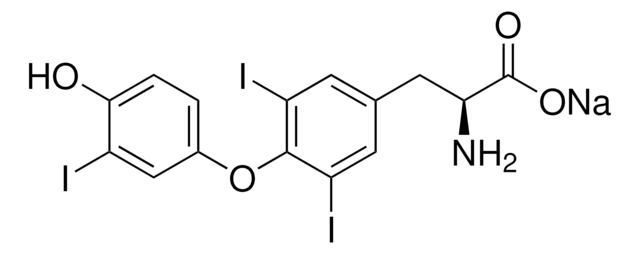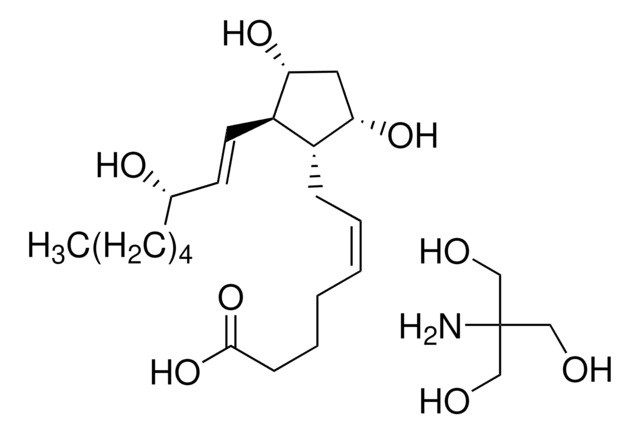N6530
N1 Medium Supplement (100×)
solution, sterile-filtered, suitable for cell culture
Synonyme(s) :
N1 Supplement
Se connecterpour consulter vos tarifs contractuels et ceux de votre entreprise/organisme
About This Item
Code UNSPSC :
12352207
Nomenclature NACRES :
NA.77
Produits recommandés
Stérilité
sterile-filtered
Forme
solution
Technique(s)
cell culture | mammalian: suitable
Impuretés
endotoxin, tested
Température de stockage
2-8°C
Description générale
N1 Medium Supplement (100×) can be used as a supplement to produce complete N1 neural cell growth media or closely related media.
Application
N1 Medium Supplement (100×) has been used as:
- a component of the proliferation medium for culturing oligodendrocyte-like cells and neuroblastoma cells
- a supplement in the Dulbecco′s modified Eagle medium (DMEM/F12) to culture human oligodendrocytes
- a component of the α-minimum essential medium (MEM) for culturing induced primary retinal pigment epithelium (ipRPE) monolayers
Autres remarques
Contains 0.5mg/ml recombinant human insulin, 0.5mg/ml human transferrin (partially iron-saturated), 0.5μg/ml sodium selenite, 1.6mg/ml putrescine, and 0.73μg/ml progesterone.
Notes préparatoires
Prepared in Earle′s Balanced Salt Solution (EBSS) without phenol red.
Produit(s) apparenté(s)
Réf. du produit
Description
Tarif
Code de la classe de stockage
12 - Non Combustible Liquids
Classe de danger pour l'eau (WGK)
WGK 1
Point d'éclair (°F)
Not applicable
Point d'éclair (°C)
Not applicable
Équipement de protection individuelle
Eyeshields, Gloves, multi-purpose combination respirator cartridge (US)
Faites votre choix parmi les versions les plus récentes :
Déjà en possession de ce produit ?
Retrouvez la documentation relative aux produits que vous avez récemment achetés dans la Bibliothèque de documents.
Les clients ont également consulté
Ludmila A Voloboueva et al.
Investigative ophthalmology & visual science, 46(11), 4302-4310 (2005-10-27)
To determine whether (R)-alpha-lipoic acid (LA) protects cultured human fetal retinal pigment epithelial (hfRPE) cells against oxidative injury and identify the pathways that may mediate protection. Cultured hfRPE cells were pretreated with various concentrations of LA for 14 to 16
Miguel Flores-Bellver et al.
Journal of extracellular vesicles, 10(13), e12165-e12165 (2021-11-10)
Age-related macular degeneration (AMD) is a leading cause of blindness worldwide. Drusen are key contributors to the etiology of AMD and the ability to modulate drusen biogenesis could lead to therapeutic strategies to slow or halt AMD progression. The mechanisms
Michael Craigie et al.
Journal of neuroimmune pharmacology : the official journal of the Society on NeuroImmune Pharmacology, 13(2), 126-142 (2017-11-22)
JC virus (JCV) is a human polyomavirus and the etiologic agent of the demyelinating disease progressive multifocal leukoencephalopathy (PML). PML is observed in patients with underlying immunocompromising conditions, suggesting that neuro-immune interactions between peripheral immune cells and neuro-glia play an
Tomasz M Stępkowski et al.
Cellular and molecular neurobiology, 37(6), 1055-1066 (2016-11-11)
Perturbations in the transport of mitochondria and their quality control in neuronal cells underlie many types of neurological pathologies, whereas systems enabling convenient analysis of mitochondria behavior in cellular models of neurodegenerative diseases are limited. In this study, we present
Lucia Lichvarova et al.
Scientific reports, 9(1), 10603-10603 (2019-07-25)
Forebrain glial cells - ependymal cells and astrocytes -acquire upon injury- a "reactive" phenotype associated with parvalbumin (PV) upregulation. Since free radicals, e.g. reactive oxygen species (ROS) play a role in the pathogenesis of multiple sclerosis, and that PV-upregulation in
Notre équipe de scientifiques dispose d'une expérience dans tous les secteurs de la recherche, notamment en sciences de la vie, science des matériaux, synthèse chimique, chromatographie, analyse et dans de nombreux autres domaines..
Contacter notre Service technique









